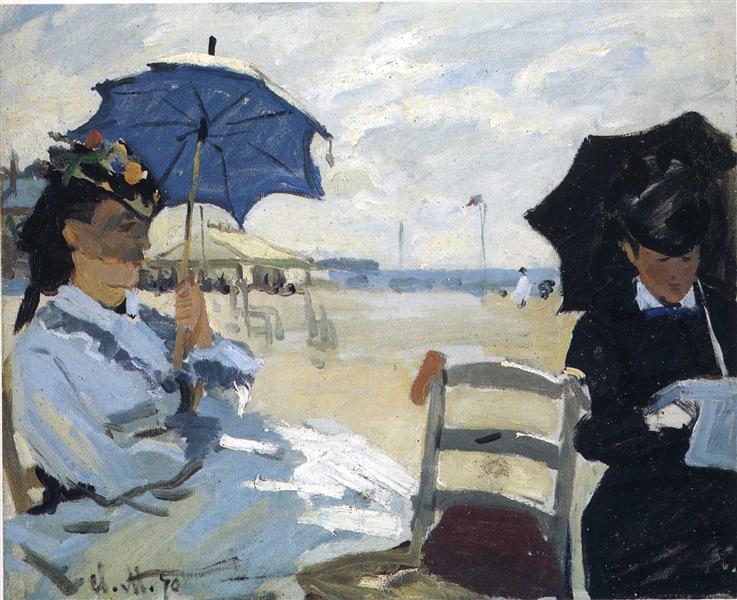Description
"The beach of Truville" by Claude Monet, painted in 1870, is a work that captures the essence of the impressionist movement in its early phase. Monet, a pioneer of this movement, achieves through this painting not only a holiday landscape, but also a vibrant atmosphere impregnated with light and color, elements that would define his work throughout his career.
The composition of "Trouville Beach" is marked by a dynamic arrangement of the shapes and a color palette that evokes the glow of the day in a maritime environment. In the foreground, the golden sand of the beach expands to the horizon, while the sea, with its soft waves, reflects a varied range of blue and green. The presence of human figures add an element of life to the scene. We see a group of bathtubs who interact with the landscape, their silhouettes in bright colored colored colors add a cheerful contrast against the soft tone of the sand. The way Monet represents people lacks precise detail on faces, suggesting a celebration of the moment rather than an obsession with realism. This choice underlines the importance of the environment above individuality.
The technique of the loose and fast brushstroke is essential in this work. Monet uses small dabs and strokes that capture light and movement almost ephemerally, which results in a subjective interpretation of reality. This way of working allows the scene to breathe, which flows with nature itself, a principle that is in the heart of impressionism. The way in which colors overlap and merge are aligned with the artist's search to capture the atmosphere, a concept that becomes more critical as art history progresses.
It is interesting to note that Monet painted this work during a summer in Truville, a coastal town in Normandy, where he and other artists discovered a new world. This place became a focal point for creativity and innovation during the nineteenth century in France, being a popular destination between high society and among artists. The scene represents not only a personal getaway, but also a look at the emergence of a new way of seeing and experiencing the world, either through the beach lens or landscape.
The intentional use of warm and cold colors allows paint to feel alive. The shadows are drawn with subtle blue and violet, contrasting with the golden tones of the sand and the sparkling white of the waves, creating a luminosity effect that emanates from the surface. This was not only an innovative technique, but also reflected the influence of light on the perception of color itself.
In conclusion, "Trouville Beach" is more than a one -day representation on the beach; It is a work that encapsulates the philosophy of impressionism, where light, color and atmosphere become protagonists of the visual narrative. Monet not only captures a place and a moment, but establishes an emotional connection between the spectator and the experience of life itself in nature. The work remains a testimony of the evolution of art in the nineteenth century, its legacy endures in the modern approach towards visual perception and artistic narrative.
KUADROS ©, a famous paint on your wall.
Hand-made oil painting reproductions, with the quality of professional artists and the distinctive seal of KUADROS ©.
Reproduction service paintings With a guarantee of satisfaction. If you are not completely satisfied with the replica of your painting, we refund your money 100%.

